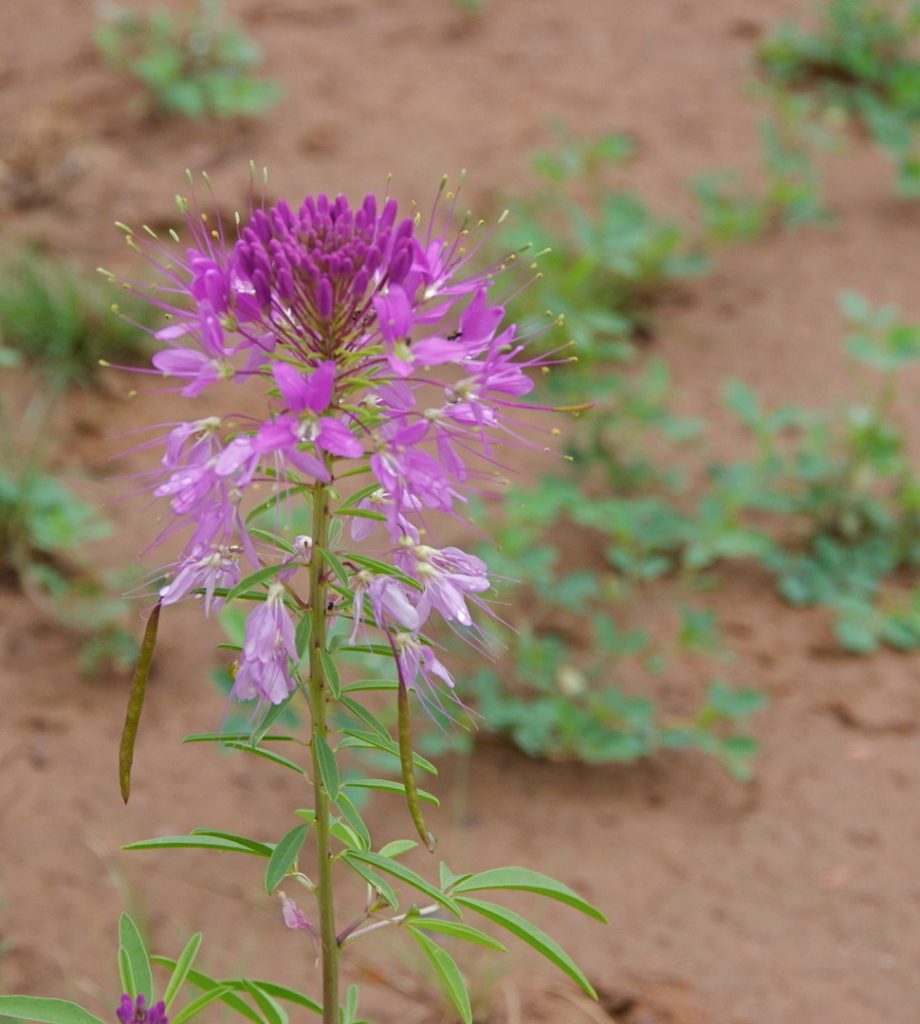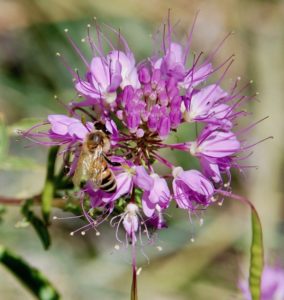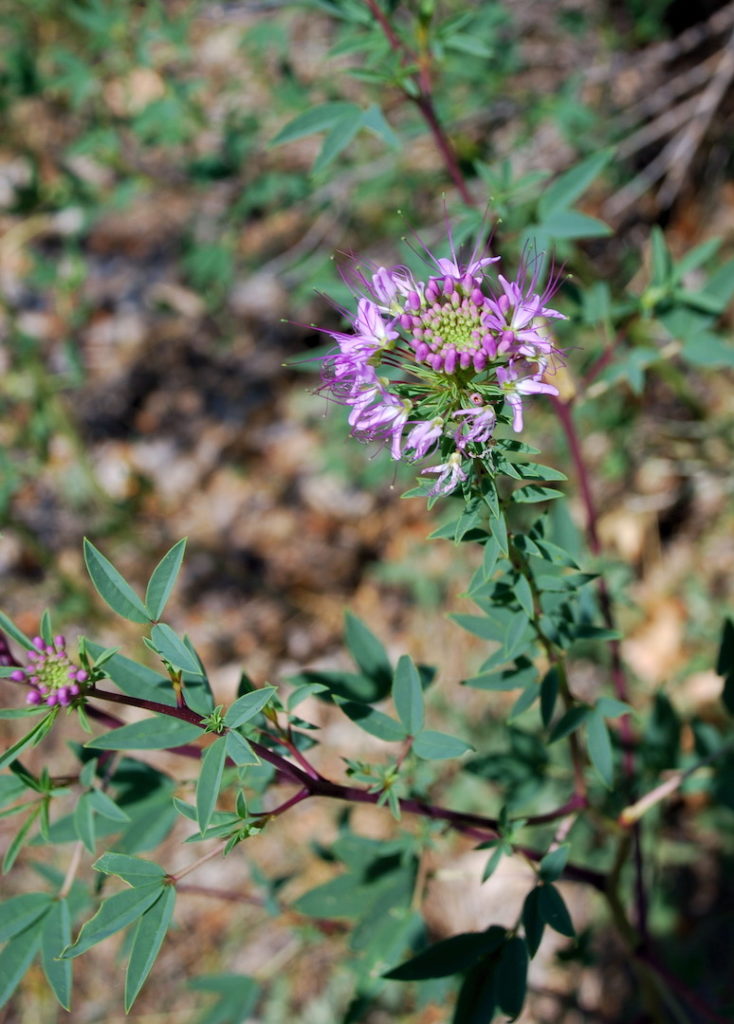Scientific name: Cleome serrulata (Pursh) (klee-OH-me ser-yoo-LAY-tuh)
Synonym: Peritoma serrulata (per-eye-TOH-muh)
Common names: Rocky Mountain beeplant, bee plant, bee spider plant and others
Plant family: Cleomaceae (spider plant) (klee-ohm-AY-see-ee)
Other Plant families mentioned: Capparaceae (caper) (kap-ar-AY-see-ee), Brassicaceae (mustard) (brass-ih-KAY-see-ee)
Article and photos by Janice Tucker

Rocky Mountain beeplant and other wildflowers in Arroyo de las Pena. Photo by Janice Tucker.
The Rocky Mountain beeplant (Cleome serrulata) is a rock star when it comes to summer wildflowers. Its natural environments include open fields, piñon-juniper woodlands, roadsides, arroyos and other moist, disturbed areas. These habitats provide the venue for its colorful performance from mid-summer into early fall.
The Rocky Mountain beeplant is native to a substantial portion of North America ranging from the Canadian province of Saskatchewan through a large swath of the western United States. It has a penchant for the dryer climates in altitudes ranging from 3,000 to 9,500 feet. However, plants do not necessarily toe the line when it comes to where they choose to grow. Rocky Mountain beeplant has spread and naturalized into much of the United States, northern Mexico and the other southern Canadian provinces.
Tall, lanky stems are lined with alternate palmate leaves comprised of 3 leaflets with either entire or minutely serrated margins. The leaves continue to the terminal end of the stems, mingling with bouquets comprised of individual lavender flowers, each with four petals underlined by 4 darker-hued sepals. Six stamens of purplish filaments, tipped with green anthers radiate from each flower and extend beyond the flower clusters. The final result is an explosion of colors and textures.

Since the Rocky Mountain beeplant’s flower clusters are racemes, they bloom from the bottom toward the terminal end of the stem. This prolongs the flowering time. A purplish (or green) center at the top of the the raceme is actually sepals of unopened flowers. Spent blooms leave behind dangling seed pods from 1 to 3 inches. The flowers and seed pods appear on the stem at the same time, which adds to its charm. The annual life cycle is complete once the pods have dispersed their seeds. At this point the plant signals that its job is done for the year and begins to fade. Fortunately each plant leaves behind thousands of seeds that will hopefully germinate the following spring and summer.
 Nectar-rich flowers accommodate pollinators with 24/7 availability. Hummingbirds, bees, butterflies and other insects are constant daytime visitors. New flowers open shortly after sunset to the delight of nocturnal pollinators. It is a larva host to the Checkered White butterfly (Pontia protodice). In addition to the birds, bees and other insects, the Rocky Mountain beeplant hedges its bets by the ability to self-pollinate.
Nectar-rich flowers accommodate pollinators with 24/7 availability. Hummingbirds, bees, butterflies and other insects are constant daytime visitors. New flowers open shortly after sunset to the delight of nocturnal pollinators. It is a larva host to the Checkered White butterfly (Pontia protodice). In addition to the birds, bees and other insects, the Rocky Mountain beeplant hedges its bets by the ability to self-pollinate.
The annual Rocky Mountain beeplant can add color and dimension to formally landscaped areas. But since most gardens have limited space, their natural, wild behavior may need to be tamed a bit. Staking the lanky branches and planting them as a backdrop to lower-growing flowers and shrubs makes for a lovely tapestry of color. The Rocky Mountain beeplant is described as having an unpleasant odor. But there are gardeners who claim they have never noticed this trait. If planted away from seated areas in the garden, its beauty can be enjoyed without worrying about a bothersome odor. There are also some sources that warn that insects – perhaps from the caterpillar of the Checkered White butterfly – feed on the leaves. While that damage may somewhat affect the plant’s aesthetics, it usually remains healthy. Although hordes of pollinators are attracted to the Rocky Mountain beeplant, most critters do not seem to find it tasty. That’s good news for gardeners.
The Rocky Mountain beeplant does best in full sun or minimal shade. Its roots like to rest in light or sandy, moist, alkaline soil that drains well. Water to keep the soil moist, but not soggy. These plants are sometimes available as bedding plants at local nurseries but most online nurseries offer only seeds. As an annual plant, propagation is by seed. Germination is deemed to be less than ideal but can be boosted with cold, moist stratification of the seeds and by using a heavy hand when sowing. (See Hamilton Native Outpost website listed in Sources below re moist seed stratification.)
 Although the Rocky Mountain beeplant is deemed to be a food source, high in vitamin A and calcium, its appearance on the dinner menu is unlikely due to its unappetizing taste. It has been brewed as a tea and cooked as a potherb to treat fevers and stomachaches. A yellow-green dye made from the Rocky Mountain beeplant accounts for some of the lovely colors in Navajo rugs and blankets. A thick, black resin made from concentrated dye is often used to paint designs on pueblo pottery and baskets. The Rocky Mountain beeplant is valuable in renovating ranges, disturbed land, and in establishing pollinator habitats. The seeds are often included in food mixes for game birds. It is not desirable for livestock and wildlife forage and is toxic if ingested in large amounts.
Although the Rocky Mountain beeplant is deemed to be a food source, high in vitamin A and calcium, its appearance on the dinner menu is unlikely due to its unappetizing taste. It has been brewed as a tea and cooked as a potherb to treat fevers and stomachaches. A yellow-green dye made from the Rocky Mountain beeplant accounts for some of the lovely colors in Navajo rugs and blankets. A thick, black resin made from concentrated dye is often used to paint designs on pueblo pottery and baskets. The Rocky Mountain beeplant is valuable in renovating ranges, disturbed land, and in establishing pollinator habitats. The seeds are often included in food mixes for game birds. It is not desirable for livestock and wildlife forage and is toxic if ingested in large amounts.
Now we turn to the dizzying topic of the Rocky Mountain beeplant’s (Cleome serrulata) scientific classifications and names. Carl Linnaeus (1707-1778), who is celebrated as the “father of taxonomy”, named the Cleomaceae family in 1753. But, because of similarities among the families of Cleomaceae (spider plant), Capparaceae (caper) and Brassicaceae (mustard) some plant classifications have been in flux for many years. All are in the Brassicales order. With the Rocky Mountain beeplant’s flower structure of 4 petals, 4 sepals and 6 stamens as well as its seed pod development, it is easy to determine a visual resemblance to the mustard family. Over the last 200 plus years the Cleome serrulata has been moved in and out of all three plant families. At present, taxonomists seem to be debating among themselves whether the classification should be Cleomaceae or Capparaceae. Who knows? Maybe it will be placed in the Brassicaceae family again. Stay tuned.
Frederick Pursh, a German-American botanist (1774-1820), assigned the classifications and scientific names to the plants collected during the 1804-1806 Lewis and Clark Expedition. He named the subject plant, Cleome serrulata. But, then Swiss botanist, Augustin de Candolle (1778-1841) decided to confuse things. He named the Peritoma as a new genus for the Cleomaceae family and moved the C. serrulata, over to become Peritoma serrulata. Apparently, not all taxonomists agreed with this move. Similar to the classification debate described above, the generic name for the Rocky Mountain beeplant depends upon the taxonomic system to which one subscribes. The genera, Cleome and Peritoma are synonyms. Either is correct. Cleome is from the Latin with a rather obscure definition of “denoting a different plant”. Peritoma is a compound word from the Greek, peri, which means “all around”, and tome, defined as “a slice”, and refers to the cut of the calyx base. The species name of serrulata, is from the Latin, which translates to “fine toothed”, supposedly describing the leaves and/or sepals with subtle serrations – with subtle being the operative word. You may need a microscope or at the very least a strong loupe to see those serrations.
The Rocky Mountain beeplant is a sight to behold when growing en masse in its natural environment. Prime time in Santa Fe is usually between mid-summer to early fall. The Santa Fe Botanical Garden’s Leonora Curtin Wetland Preserve provides an excellent stage for the yearly dance of the Rocky Mountain beeplant. A large stand thrives at the southeast end of the Aster Bridge where it grows wild and free in joyful abandon, paying no attention to the official description of “erect stems”. The leaf-clad branches twist and swirl, causing the pendulous seed pods to shimmy in the wind like the fringe lining the hem of a 1920’s flapper’s dress. Clusters of lavender flower heads sway in the breeze, adding colorful animation to a show-stopping performance. And that’s not all. It is almost impossible to stand on the bridge without witnessing a parade of pollinators surrendering to the temptation of the nectar-filled flowers. Visit the Leonora Curtin Wetland Preserve to delight in this floral display brought to us at no charge, compliments of Mother Nature.

Rocky Mountain beeplant field

Rocky Mountain beeplant at LCWP southeast side of Aster Bridge
Thanks to Helen Woody and Jeanne Gozigian for proofreading this article.
Sources consulted and/or cited:
“Capparaceae family (caper)”. Wikipedia. 19 Feb. 2019. Web. Accessed 03 Mar. 2019. Retrieved from: https://en.wikipedia.org/wiki/Capparaceae.
“Cleomaceae family (spider plant)”. Wikipedia. 15 Mar. 2019. Web. Accessed 03 Mar. 2019. Retrieved from: https://en.wikipedia.org/wiki/Cleomaceae .
“Cleome serrulata Seeds Rocky Mountain Bee Plant Seeds”. High Country Gardens. 2019. Web. Accessed 03 Mar. 2019. Retrieved from: https://www.highcountrygardens.com/wildflower-seeds/individual-species/cleome-serrulata-seeds.
“Cleome serrulata”. Garden Explorer. Santa Fe Botanical Garden. 20 May. 2019. Web. Accessed 22 May 2019. Retrieved from:https://santafebotanicalgarden.gardenexplorer.org/default.aspx#Taxon-334.
“Cleome serrulata”. Native Plant Database. Lady Bird Johnson Wildflower Center. 30 Aug. 2018. Web. Accessed 03 Mar. 2018. Retrieved from: https://www.wildflower.org/plants/result.php?id_plant=CLSE.
“Cleome serrulata (Rocky Mountain beeplant”. Wikipedia. Sept. 2018. Web. Accessed 03 Mar. 2019. Retrieved from: https://en.wikipedia.org/wiki/Cleome_serrulata.
“Cold Moist Stratification Guide”. Hamilton Native Outpost, Native Grass and Wildflower Seeds. Web. Accessed 24 April 2019. Retrieved from: https://www.hamiltonnativeoutpost.com/how_to_stratification.php
Curtin, Leonora S.M. Healing Herbs of the Upper Rio Grande Traditional Medicine of the Southwest. Revised and Edited by Michael Moore. Santa Fe, New Mexico: Western Edge Press, Second Edition 1997. Print.
National Audubon Society Field Guide to Wildflowers Western Region. New York City: Alfred A. Knopf, Inc, Revised Edition 2001. Print.
Pendusi, Teresa. “Rocky Mountain Bee Plant (Cleome serrulata). Forest Service Plant of the Week.” USDA, NRCS. 2019. The PLANTS Database (http://plants.usda.gov, 03 Mar. 2019). National Plant Data Team, Greensboro, NC 27401-4901 USA.
“Peritoma serrulata (Rocky Mountain beeplant)”. SEINet Portal Network, 2019. Web. Accessed 14 May 2019. Retrieved from:
http//:swbiodiversity.org/seinet/index.php .
Schneider, Al. “Peritoma serrulata”. Southwest Colorado Wildflowers. 01 Mar. 2019. Web. Accessed 03 Mar. 2019. Retrieved from: http://www.swcoloradowildflowers.com/Pink%20Enlarged%20Photo%20Pages/peritoma%20serrulata.htm .
Winslow, Susan. “Rocky Mountain Beeplant (Cleome serrulata Pursh) Plant Materials Technical Note No. MT-104”. USDA, NRCS. 2019. The PLANTS Database (http://plants.usda.gov, 03 Mar. 2019). National Plant Data Team, Greensboro, NC 27401-4901 USA.


